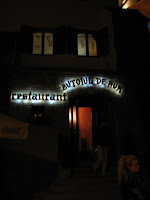

Stepping down from the bus, we descend into the medieval city of Sibui. It has been designated the Cultural Capital of Europe together with Luxembourg this year. Banners are flying everywhere noting this designation. Even the sewer drains have joined the celebration. It is another town very much influenced by German occupation. The buildings are shoulder-to-shoulder in the square. Sibui boasts the oldest museum in the world. It seems that one of the richer merchants in town became very rich during his lifetime and built himself a huge house on the square. He collected fine paintings as a hobby. He filled it with fine paintings and objets d’art. In his later life he opened his house to the public for viewing. It is at the end of the row. It is still an excellent museum today. This Big Square is huge with a fountain in the center. We managed to get here just in time to see these nuns frolicking in the fountain.
The Old Town has been renovated to that walking through the town square has the distinct feel of walking into another time. The stone buildings are perfect and the stucco has fresh paint. It looks just as you would imagine a German town to look several centuries ago. Although there are banks and photo stores, they have managed to maintain the Old World image

We wandered from the centre to the city walls. This was once a fortified city with an outer wall and a moat protecting the inner walls and the city from invaders. I am looking at the city from the moat which is fortunately not filled with water at the moment. It seems that each guild was charged with building and manning a single tower and connecting wall. There are thirteen towers in Sibui, so there were thirteen guilds. The shoemakers


It wasn’t long before we were back in the Big Square. I found this little sidewalk café and thought immediately of my Lithuanian friends. No champagne but an excellent time was had by all.
We passed through the Big Square again through this interesting tunnel into the Little Square.






The afternoon has flown by and it is time to meet for dinner. Heading back to the Big Square this quirky little alleyway appears. People are using it as if it were a freeway. I wonder where it leads.
We find the group and head for dinner in a hidden grotto. Another gastronomical delight!
It was daylight when we arrived at the Golden Barrel! Lights are on all over the Big Square as we walk back to our 




No comments:
Post a Comment